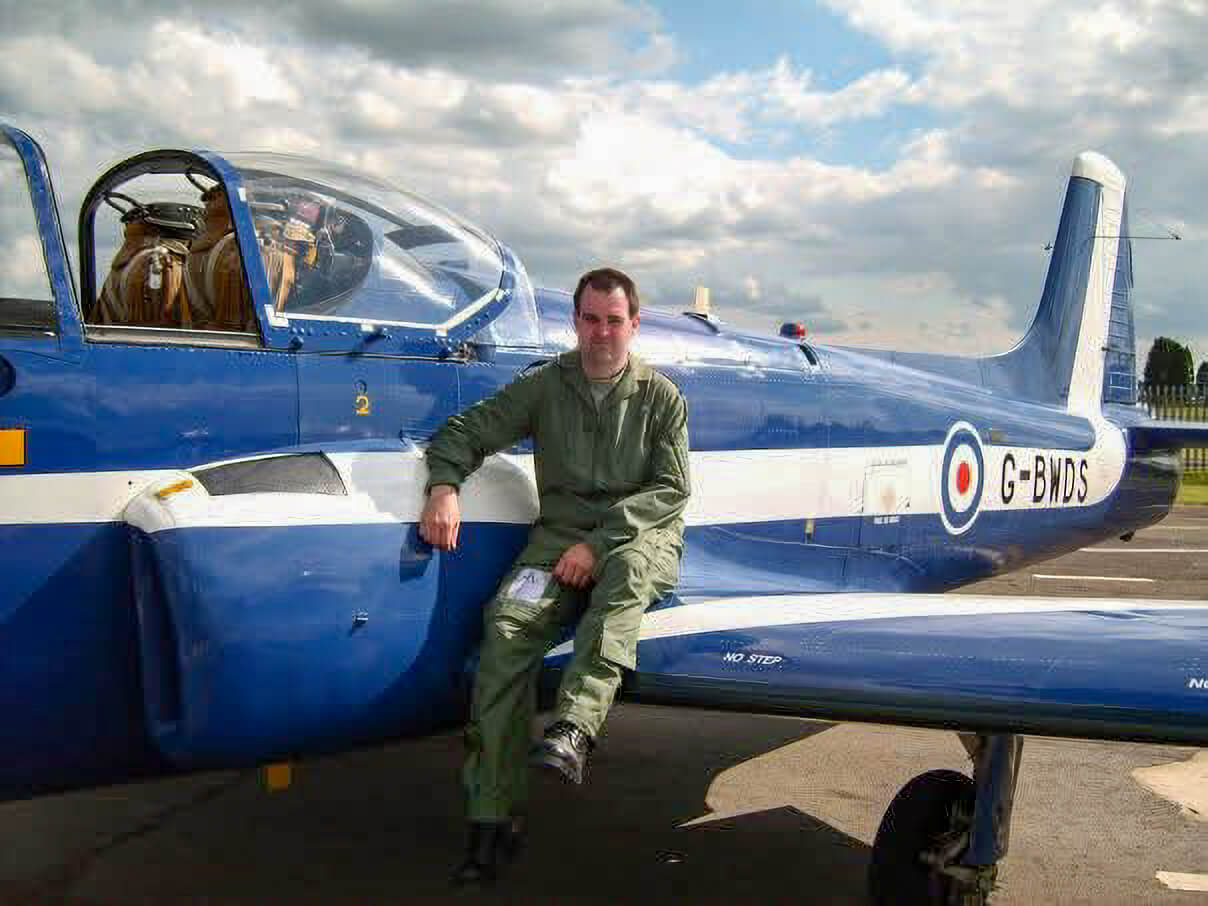From aerospace hobbyist to composites specialist - Meet forward-thinker Neil Dykes
From privately built rockets to next-generation aircraft materials, engineer Neil Dykes has spent his career pushing the limits of aerospace composites. With a background in polymer science and aviation, he has worked in automated composite manufacturing, rocket engineering, and aircraft construction and restoration. Here, we explore his journey — from early post-graduate research at Cranfield University to co-developing the UK’s most powerful privately-built rocket — and his current role as manager of technical sales at Exel Composites, where he applies his expertise to the future of composite materials.
Neil Dykes’ fascination with flight began in childhood, growing up near Manchester Airport where he watched aircraft flying low overhead. His professional career in polymer engineering began with rubber compounding, but his focus soon shifted to high-performance composite materials.
After earning a degree in polymer science and technology, Dykes later conducted research at Cranfield University on integrating fiber optic sensors and acoustic emission monitoring within carbon fiber-reinforced polymer (CFRP) aircraft structures. This was designed to detect early-stage structural failures, a critical advancement for structural health monitoring (SHM) in next-generation aircraft.
Building on this expertise, Dykes transitioned into automated composite manufacturing, refining processes for primary and secondary aircraft structures. Technologies like automated fiber placement and resin transfer molding allowed tighter tolerance, reduced void content, and optimized fiber orientations, ensuing aerospace components met strict load bearing and fatigue resistance standards. His proficiency in finite element analysis and lightweight structural design allowed him to be at the forefront of high-strength, low-weight component development.
Dykes later founded a business supplying carbon, glass, and hybrid fiber tubes and profiles. The company provided bespoke composite products, tailoring solutions to specific mechanical and cost requirements. One of the more public projects was a sculpture located by the Lowry Centre (Manchester, UK) depicting blades of grass six meters tall.
“It was exciting to do an outdoors installation, and we completed both the design and manufacture of the sculpture on time and on budget” says Dykes.
This also marked his first foray in radio frequency (RF)-transparent composite structures. Unlike traditional materials, these glass fiber composites enable seamless electromagnetic wave transmission, a crucial factor in high-performance antenna systems. This experience allowed him to refine his problem-solving approach, where composites had to not only be strong and lightweight, but scalable, durable, and precisely engineered for the application.
Through this work, he established an early connection with Exel Composites, which would later play a pivotal role in his career.
Pushing aerospace boundaries
In 2011, Dykes collaborated with Bolton Technical Institute on a STEM education initiative — designing and launching Black Streak, the most powerful privately-built rocket in the UK at the time.
The five-meter carbon fiber airframe incorporated a glass fiber RF-transparent payload bay, ensuring real-time telemetry transmission for tracking aerothermal loads and stage separation dynamics.
The multi-stage rocket, propelled by solid fuel motors within pre-loaded aluminum/graphite combustion chambers, was engineered to reach Mach 2 and altitudes of 55,000 feet. However, launching a high-speed projectile into UK airspace required stringent regulatory approvals, particularly due to the launch site of The Mull of Galloway being positioned within a transatlantic flight corridor. Clearance delays and weather-related visibility issues on launch day complicated tracking efforts.
Despite the successful ignition of both first and second-stage motors, electrical failures arose when avionics systems failed, resulting in a complete telemetry blackout. Compounding the challenge, the nose-cone — housing crucial flight data — was lost at sea, preventing official altitude verification. Whilst the upper stage was never retrieved, the first-stage booster was successfully recovered via parachute and the second stage was found floating in the sea, surviving the return without a parachute.
Despite these shortfalls, the project provided students with immersive aerospace engineering experience, exposing them to multi-stage ignition sequencing, RF shielding complexities, and the inherent challenges of rocket development.
From aircraft engineering to material science
Dykes’ passion for aviation extends well beyond composites — he earned his private pilot license in 2009 and has built and restored over 40 aircrafts, ranging from ultralights to ex-military jets. This experience spans both restoration and manufacturing, including the rebuild of a WWII Spitfire and leading microlight production as general manager at P&M Aviation.
His work in specialized aircraft modifications included the development of external smoke tank systems for aerobatic ex-airforce jets. These systems used precisely metered diesel injection into the exhaust manifold, generating a dense, visible smoke trail — essential for airshow performances and formation flight coordination.
Currently, Dykes is rebuilding a Campbell Cricket autogyro, applying advanced composite structures to enhance weight reduction and structural resilience. Though work commitments have reduced his flying time, he continues to explore unpowered flight dynamics through paragliding.
Dykes’ long-standing relationship with Exel Composites began as a customer, utilising its high modulus carbon fibre composite pultrusions for communication mast systems and later integrating its advanced composite materials into aerospace structures requiring high strength-to-weight ratios and fatigue resistance. Years of collaboration led to his recruitment by Kim Sjödahl, senior vice president of technology and sustainability at Exel Composites, who recognised the strategic value of his cross-sector expertise.
A chance encounter with Richard Thomas, then business unit manager at Exel Composites, reinforced the transition — Thomas still had the business pen from their first meeting in 2014, showing the long-term connection, and the benefits of effective merchandising.
Now in his role as Manager for Technical Sales at Exel Composites, Dykes applies his aerospace background to a multitude of customer projects, focusing on helping customers with their design proposals, laminate optimizations and cost performance. His experience in tackling complex, multi-faceted problems has been essential in developing next-generation composite solutions for industries such as aerospace, energy and infrastructure.
“I think that’s why I get easily bored in production,” reflected Dykes. “For me, it’s all about solving the puzzle, figuring out how to make something work, setting up the tools and getting everything running smoothly. Once I’ve cracked the challenges and got that one perfect metre, I’m satisfied. After that, it’s all about handing it over to someone else to scale it up. The excitement is in finding the solution and making it work, not in just repeating it over and over.”
The future of aerospace composites
Dykes believes that the future of aerospace composites relies on achieving a precise balance between weight optimisation, mechanical strength and fatigue resistance, all while advancing non-destructive testing methodologies to detect microstructural failures earlier. Advancements in composite materials continue to open new possibilities for fail-safe structural designs, offering enhanced strength, durability and performance.
Beyond material science, Dykes champions cost-driven decision-making as a way of improving engineering quality. As aerospace manufacturers pursue greater production efficiency and supply chain optimisation, he stresses the importance of maintain stringent testing protocols and structural certifications standards to uphold safety margins.
Without rigorous oversight, the push for faster production and cost reductions risks compromising fundamental engineering principles.
Neil Dykes’ career showcases the transformative power of composite materials in aerospace engineering, from enhancing aircraft durability to enabling high-performance rocket structures. Now, Dykes applies his expertise at Exel, focusing on advancing the next generation of composite manufacturing to meet the industry’s evolving demand for lighter weight, higher strength, and exceptional performance.
Read more about how composites are being used in all aspects of transportation by visiting here.


